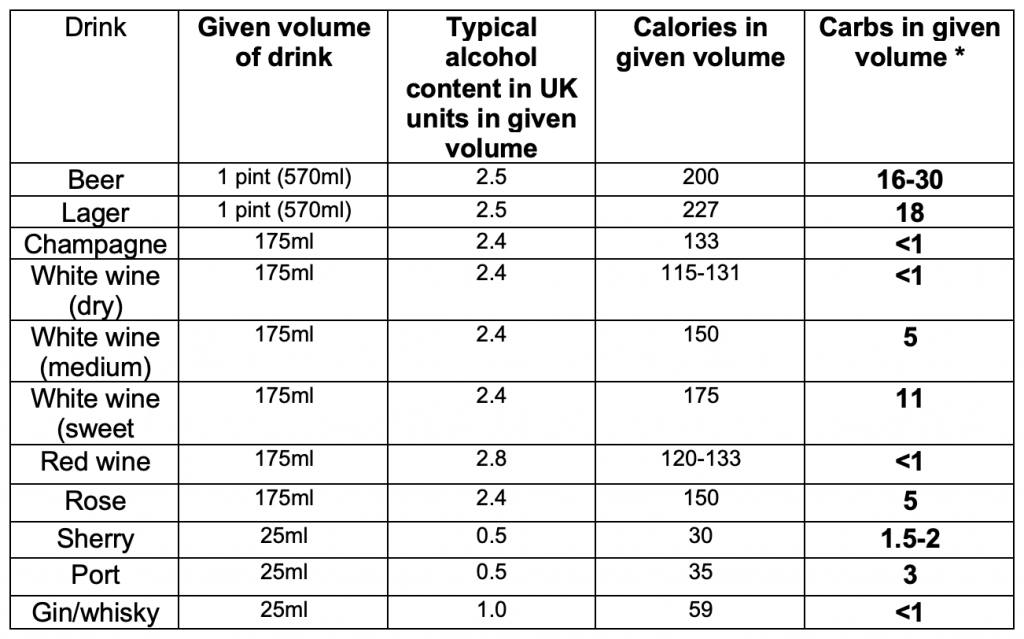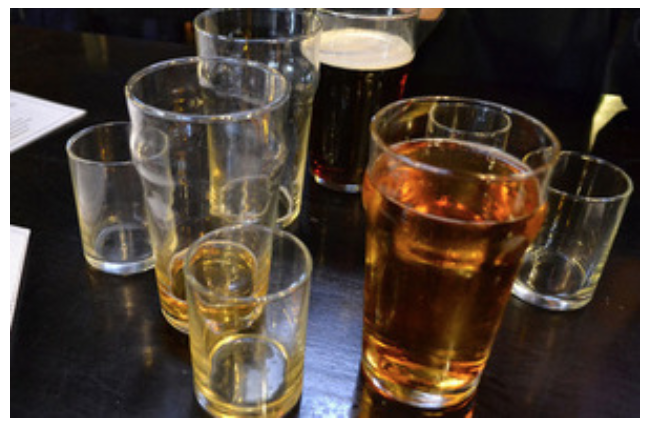Alcohol – some basic information
Even if you never touch a drop of the stuff you still need to deal with alcohol. Alcohol is present in small amounts in overripe fruit. I, and it is also produced as a by-product of the fermentation of food as it passes through the gut. And because alcohol is a toxic substance, we all have chemical systems standing by ready to break it down. That standby is an enzyme called alcohol dehydrogenase (ADH) and it lives in the liver. As a matter of fact, almost all animals, even humble bacteria, have ADH or similar enzymes. That is because nasty, lovely, toxic old alcohol is a pretty ubiquitous substance. But alcohol is important for those wishing to reverse their diabetes. It is a food-energy source and, particularly when taken in the late evening, can delay the switch to glycogen burning and the fasting state.
Table The metabolism of alcohol

Notes:
- Alcohol dehydrogenase is the enzyme the liver uses to break alcohol (ethanol) down
- Acetaldehyde is the first break-down product. This is a nasty little compound which can cause tissue damage. Thankfully it doesn’t last for long before it too is broken down. Vitamins C and B1 (thiamine) protect against the damaging effects of acetaldehyde
- Acetate or acetic acid, yes vinegar. Perhaps where the phrase getting pickled comes from. This combines with Co-enzyme A and enters the…
- … Kreb’s’s cycle; a series of chemical steps that generate cellular energy-storing compounds and produces water and carbon dioxide as its end products.
So, how much alcohol is in a drink? Depends on the type of drink and how much of it is consumed. Table The table below gives you some figures to work with. Note carefully: the alcohol content of beer, for example, can range from just over 3% to 9%; check the label. Note also that the volume you drink may differ from the examples given above. The % of alcohol is sometimes called the alcohol by volume (ABV).
Table: The alcohol, calorie and carb content of various drinks

These figures are ball-park estimates. Information sources vary widely on their figures for calorie, carb and alcohol data, even for very similar drinks. Serving sizes vary too. In the US, drinks come in fluid ounces. I, in most other places it’s it is in mls. I have used mls with the exception of beer and lager, which are presented in UK standard pints. Pints in the US are 16 fl.oz., 20% smaller than in the more generous 20 fl.oz. ones served in the UK. Confused?
There is a significant difference in carb-counts between brewed beverages like beer and lager, and dry wines including Champagne. Beers and lagers contain the sugar maltose from the malt used to feed the yeast. Ciders, too, contain sugars which can come from the fruit but may be added as sucrose as well. Ciders can have a very high carb-load at up to 20g per pint. This is the equivalent of around 5 teaspoons of sugar. There are many lower-carb ciders out there which are much lighter in sugar. Unlike beers and wine, ciders often have a nutritional information box for you to check out.
I have not added data for alcopops, cocktails, Baileys, non-diet mixers, punches, mulled wines etc. etc. It should be pretty obvious that these are high-carb offerings that have no place in the low-carb Beating Diabetes approach to healthy eating.
All alcohol-containing drinks will raise blood alcohol levels. The more grams of alcohol there is in the drink, the higher blood levels will go. The actual level will vary a little from person to person and whether and whether it was consumed with a meal or not. But the chart below gives you an idea of what a number of drinks can do to blood alcohol levels. The liver removes the alcohol at a steady rate until it is all gone. There isn’t anything you can do to speed this up. Note: These figures roughly correspond to changes seen in an 82Kg person, and where one drink contains 8g of alcohol. 8g of alcohol is equivalent to the UK’s’s 1 unit of alcohol. The blood alcohol concentration (BAC) figures are rounded to 2 decimal places.
Approximate alcohol clearance times

If you combine information from the tables above, you can work out roughly what effect the drink will have on your blood alcohol level. So, for example if you drink two 175ml glasses of white wine, you will have consumed 38.4g, of alcohol (4.8UK units). This will raise you blood alcohol level to around 0.06mg/l and it will take roughly and on average around four and a half hours for levels to drop down to zero. If your glass is more generous, or the alcohol stronger, the level will go higher and the time to complete clearance will be extended. Alcohol clearance is affected by gender, whether it has been taken with a meal or on an empty stomach, and a number of other variables. When alcohol and its metabolites are present in your bloodstream, they will be become an energy source. Some would contend that alcohol is the fourth “macronutrient” or food type (the others being carbs, fat and protein). Alcohol can also interfere with blood glucose levels and the way insulin works. Drinking alcohol before bed will delay your switch into liver glycogen burning mode. As you can see, having a very modest two units will result in alcohol lingering in the blood stream for at least a couple of hours. The take away messages are therefore…
- 1. If you wish to enjoy alcohol, choose low-carb alcohol drinks
- 2. Keep your alcohol intake modest. Alcohol can interfere with the beneficial effects of low-carb dining
- 3. Do not drink alcohol late in the evening. No wine after nine is my motto.
Warning: You must not use the data presented here to work out when it might be safe for you to drive. The data presented is for general information. Many other factors can affect the rate of alcohol clearance from the blood stream. There is nothing you can do to speed it up, but it can be slowed down. The only safe level of alcohol for driving or operating machinery is nil; zero.
This article is based on one of the Appendices in Beating Diabetes the Low-carb way. Further details can be found in the Published Work pages

